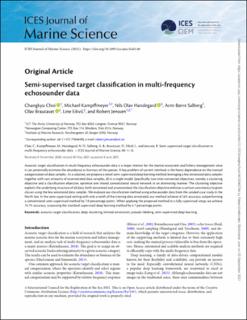Semi-supervised target classification in multi-frequency echosounder data
Choi, Changkyu; Kampffmeyer, Michael; Handegard, Nils Olav; Salberg, Arnt Børre; Brautaset, Olav; Eikvil, Line; Jenssen, Robert
Peer reviewed, Journal article
Published version
Permanent lenke
https://hdl.handle.net/11250/2786868Utgivelsesdato
2021Metadata
Vis full innførselSamlinger
- Articles [3012]
- Publikasjoner fra CRIStin [3070]
Sammendrag
Acoustic target classification in multi-frequency echosounder data is a major interest for the marine ecosystem and fishery management since it can potentially estimate the abundance or biomass of the species. A key problem of current methods is the heavy dependence on the manual categorization of data samples. As a solution, we propose a novel semi-supervised deep learning method leveraging a few annotated data samples together with vast amounts of unannotated data samples, all in a single model. Specifically, two inter-connected objectives, namely, a clustering objective and a classification objective, optimize one shared convolutional neural network in an alternating manner. The clustering objective exploits the underlying structure of all data, both annotated and unannotated; the classification objective enforces a certain consistency to given classes using the few annotated data samples. We evaluate our classification method using echosounder data from the sandeel case study in the North Sea. In the semi-supervised setting with only a tenth of the training data annotated, our method achieves 67.6% accuracy, outperforming a conventional semi-supervised method by 7.0 percentage points. When applying the proposed method in a fully supervised setup, we achieve 74.7% accuracy, surpassing the standard supervised deep learning method by 4.7 percentage points.
